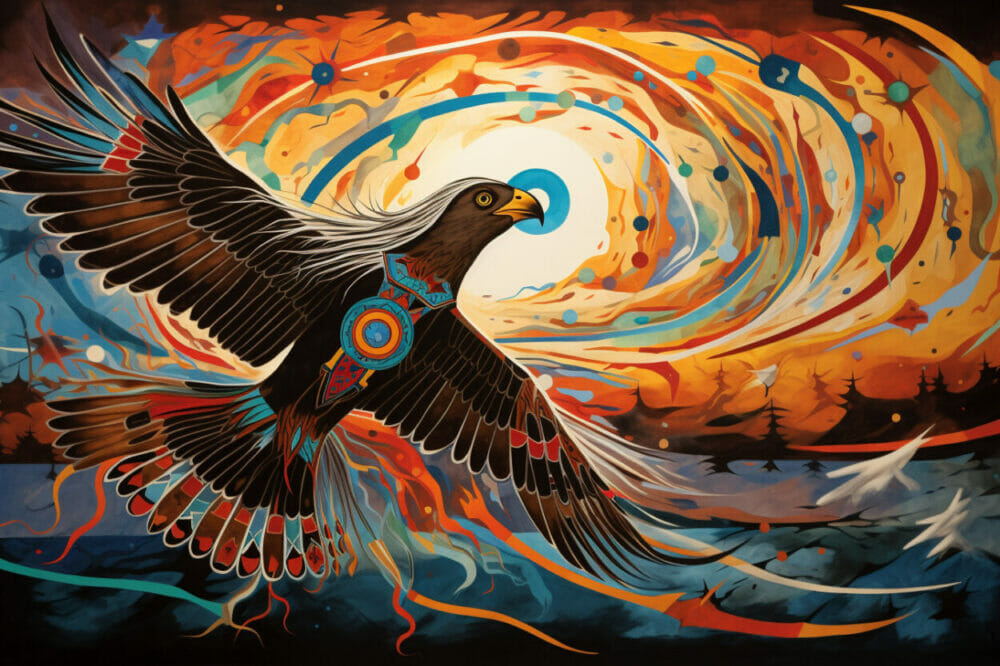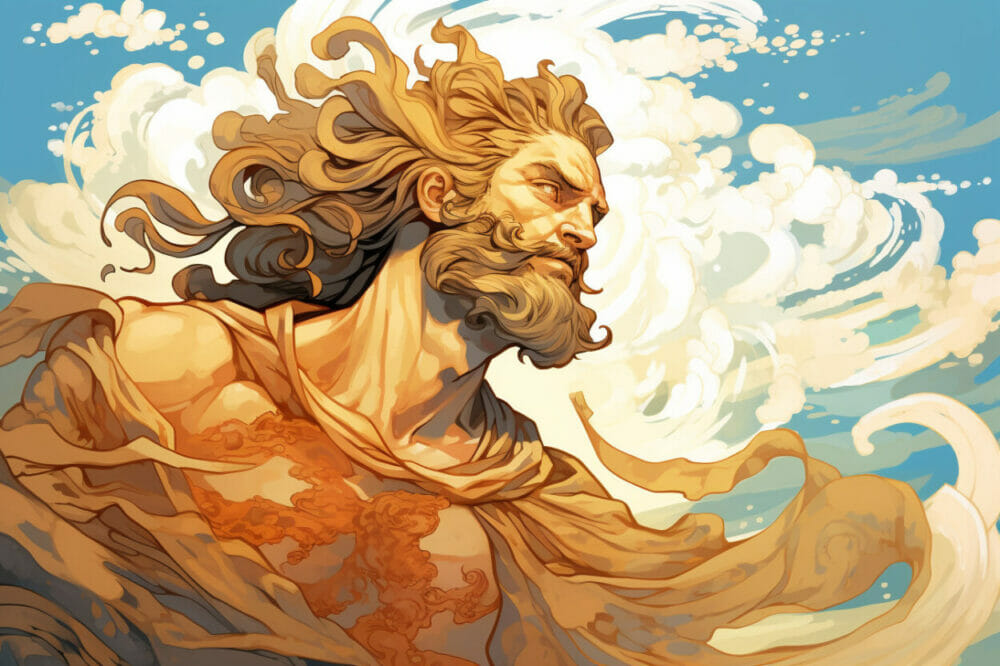Wind Symbolism Across Cultures and Religions Around The World
The wind symbolism is honestly so prevalent throughout literature and culture around the world with great complexity that exploring those meanings sure is an interesting experience.
In this article, let’s find out those symbolism for wind around the world, and how you can incorporate those symbolism into your daily life to remind you of the beauty a wind represents.
Table of Contents
- What is Wind?
- Significance of The Wind In Cultures Around The World
- Top Most Common Wind Symbolism
- 1. Change and Transformation
- 2. Freedom and Independence
- 3. Renewal and Rebirth
- 4. Travel and Exploration
- 5. Communication
- 6. Life Force
- 7. Harmony
- 8. Spiritual Guidance
- 9. Unseen Forces
- 10. Destruction
- 11. Creativity
- 12. Endurance
- 13. Chaos
- 14. Serenity and Calmness
- 15. Intuition
- 16. Temporal Nature of Existence
- Wind Symbolism in Native American Culture
- Wind Symbolism in Greek Mythology
- Wind Symbolism in Chinese Philosophy
- Wind Symbolism in Christianity
- Wind Symbolism in Norse Mythology
- Key Takeaways
What is Wind?
Wind is the natural movement of air. It happens because the sun heats different parts of the Earth unevenly, causing air to move from high-pressure areas to low-pressure ones. This movement is what we feel as wind.
Significance of The Wind In Cultures Around The World
Wind has always been important in human life. For prehistoric people, it helped with farming and sailing. It also showed up in stories, religions, and spiritual practices. Many cultures saw wind as a sign of unseen power, energy, and change.
Top Most Common Wind Symbolism
1. Change and Transformation

Wind moves constantly, and that is a metaphor for change due to its dynamic nature. Change is an inherent part of life, and similarly wind never remains stagnant. It continuously shifts, carrying with it the potential for transformation. The consistent motion of wind reflects how change is an ever-present force that shapes our experiences. We can always adapt, grow, and embrace the evolving nature of our lives.
📈 Read More: Top Symbols of Growth and Progress Around The World
2. Freedom and Independence
Wind moves freely in any direction. It doesn’t really have restriction, and is not easily confined by obstacles. This makes it an interesting symbol of freedom. Imagine standing on a wide, open field with the wind gently brushing against your skin. The wind goes wherever it pleases, without any limits or boundaries, symbolizing the ability to move and explore without constraints.
In fact, in literature and movies, the wind imagery has many times been used to describe the idea of freedom. We call someone having a sense of spontaneity, independence, and freedom as “like the wind”. They are hard to pin down, much like the wind can’t be grasped or confined. We see images of characters standing in the wild open field, with the wind blowing through their hair, representing their pursuit of independence.
3. Renewal and Rebirth

Think of the wind that comes just before spring, the breeze that clears away winter’s heaviness. Wind has always been seen as a cleansing force that wipes away the old and brings in something fresh. In this way, it mirrors cycles in life: endings followed by beginnings. It’s the breath of nature starting over. Wind doesn’t just remove what’s dead; it helps make space for what’s next. That makes it a fitting symbol for rebirth, healing, and second chances.
🐦🔥 Read More: Symbols of Rebirth Around The World
4. Travel and Exploration

From ancient sailboats to modern planes, wind powers movement. Explorers once relied on wind to discover new lands, and migratory birds still use it to travel long distances. Symbolically, wind represents the drive to venture into the unknown—not just physically, but mentally and spiritually. It encourages curiosity, risk-taking, and growth. The idea of being carried by the wind touches on our wish to go beyond what we know and discover new possibilities.
🦅 Read More: Feather Symbolism: A Detailed Compilation of Meaning Across Cultures
5. Communication
Even though we can’t see wind, it carries things: scents, sounds, and messages. In the past, tribes used smoke signals, which traveled with the wind to warn or inform others. Animals rely on wind to detect smells or signals from afar. Because of this, wind is seen as a messenger, a force that connects distant people and places. In symbolic terms, it can represent emotional messages, intuition, or even spiritual signs that arrive quietly but meaningfully.
6. Life Force

Wind is the Earth’s breath. It moves air around the planet, spreads seeds, carries moisture, and helps keep temperatures in balance. Without wind, life couldn’t survive. It keeps ecosystems in motion, pollinates plants, and refreshes stagnant air. Many cultures have connected wind to the breath of life itself. In this way, wind symbolizes not just physical breath, but the vital energy that moves through all living things.
🐝 Read More: Bee Symbolism Across The World
7. Harmony

When you feel a gentle breeze on your skin, you feel so peaceful and calm, especially when it is a scorching hot day. Wind feels so refreshing on those days, and we can’t forget the wind chimes. With the backdrop of the summer day, the tinkling of the wind chimes adds an extra layer of enchantment to the scene. It’s as if nature itself is playing a tranquil melody just for you, inviting you to relax, enjoy the moment, and appreciate the beauty of the world around you.
A slightly windy day is also amazing for outdoors activity, and also a great opportunity for people to connect with each other and simply enjoy the moment.
☯️ Read More: Symbols Of Harmony Across Cultures
8. Spiritual Guidance
Wind is like a gentle whisper, carrying messages to us, which shares several similarities with spiritual guidance that feel like quiet thoughts or insights that help us make the right decisions in life. Wind is invisible but can totally be felt, just like how spiritual guidance is not that visible to the eye, but it can still totally be sensed or felt in our hearts and minds.

9. Unseen Forces
We know wind exists because we see its effects: trees swaying, dust blowing, waves rising. But we can’t grab it or see it directly. This makes wind a symbol for invisible powers: emotions, fate, destiny, or cosmic energy. Sometimes, things move us. Gut feelings, sudden urges, coincidences, anything that seem random but meaningful. Wind helps explain this idea: that unseen forces can shape what happens in the world and within ourselves.
10. Destruction

Wind isn’t always gentle. Storms, hurricanes, and tornadoes show how wind can destroy. In these cases, wind becomes a symbol of chaos and power, tearing down buildings, uprooting trees, and turning the world upside down. This reminds us that nature is not always soft.
Like many forces in life, wind can both give and take. Symbolically, this duality reflects the darker side of change: necessary at times, but also painful.
11. Creativity

Like inspiration, wind often comes out of nowhere and changes direction fast. That’s why it’s connected to creative thought and imagination. Artists, writers, and thinkers often describe ideas as “blowing in” or “floating on the wind.” Creativity flows, drifts, and surprises, just like the wind. Wind reminds us to stay open to sudden insights and to let ideas come and go naturally, without forcing them.
12. Endurance
Wind keeps moving, never stopping. Endurance is also about not giving up and persisting through challenges, just like the wind’s constant motion. When encountering challenges, we must face them head-on and not letting them stop us, just as wind doesn’t stop even when it meets resistance. Wind can push through obstacles like mountains and buildings, and endurance means pushing through challenges and not giving up, just like the wind doesn’t stop when it encounters barriers.
💪 Read More: 22 Symbols of Resilience Around The World
13. Chaos
Sudden gusts, changing directions, unexpected storms. Wind can be unpredictable. That’s why it’s used to represent chaos or emotional unrest. In stories, wild wind often mirrors inner turmoil. A storm outside can reflect a storm within. Wind that throws things out of place symbolizes disorder, change we didn’t ask for, or moments in life when we lose control. It captures that feeling of things being scattered and unstable.
14. Serenity and Calmness

On the other side of chaos is calm. A soft breeze can cool the air, slow the mind, and bring peace. Artists often use the image of gentle wind to create a sense of serenity. In real life, sitting under a tree while the wind brushes past can instantly make us feel more grounded. This makes wind a symbol of quiet joy, relaxation, and being present in the moment.
🪷 Read More: Lotus Symbolism Across Cultures
15. Intuition
Like a whisper or a gut feeling, intuition moves us subtly, without sound or proof. Wind, too, is felt but not seen. That’s why it represents inner knowing. Just as wind nudges leaves or ripples water, intuition gently nudges us toward certain choices or away from danger. It’s not always logical, but it’s often right. Wind captures that silent, invisible wisdom that helps guide us without needing explanation.
16. Temporal Nature of Existence
Everything in life is temporary and always changing. Experiences, relationships, and even life itself don’t last forever. Life is like a river: constantly flowing and evolving. Understanding this helps us appreciate the present, learn from the past, and adapt to change.
Wind Symbolism in Native American Culture

Many Native American cultures see wind as a messenger, carrying prayers and messages to the spirit world. Wind is also associated with cleansing and renewal, as well as representing the breath of life. For example, many Native American cultures see wind as a messenger, carrying prayers and messages to the spirit world.
The Blackfoot people of the Great Plains have a wind myth that explains the origin of wind. According to their story, the creator god Napi creates the wind by releasing four powerful birds from a bag. These birds become the four winds, each with its own characteristics. The wind is seen as both a messenger and a force of change in their mythology.
Wind Symbolism in Greek Mythology

Aeolus was the god of the winds and is one of the most well-known figures associated with wind in Greek mythology. He was given the task by the gods to control the winds and prevent them from causing chaos and storms. Aeolus is mentioned in Homer’s “Odyssey,” where he helps Odysseus by giving him a bag of winds to aid his journey home.
Another Greek God symbolizing wind is Boreas. He is the personification of the north wind, often associated with cold, blustery weather, and winter conditions.
In mythology, Boreas’s most notable interaction is with Oreithyia, an Athenian princess. He fell in love with her and, in some versions of the story, abducted her to his home in the North. They had sons together, who became associated with various aspects of the cold northern winds.
Boreas symbolizes the harshness and intensity of the cold northern winds, especially during winter. His story reflects the power of nature and the sometimes tumultuous forces that shape the seasons.
Wind Symbolism in Chinese Philosophy
The Feng element, often translated as “Wind,” encompasses more than just the literal movement of air. It embodies the qualities of change, growth, movement, and adaptability. Feng represents the dynamic nature of life and the ever-shifting patterns that influence everything from nature to human experiences. It is the constant flux and transformation in the natural world.
Feng Shui, the practice of harmonizing environments for positive energy flow, utilizes the Feng element. Wind’s movement patterns are analyzed to ensure energy flow aligns with beneficial Qi (life force energy). Then we have wind-related symbols like wind chimes are used to enhance energy circulation and activate positive vibrations.
Wind Symbolism in Christianity
One of the most significant stories with wind symbolism in Christianity is the event of Pentecost. According to the New Testament in the Book of Acts, on the day of Pentecost, after Jesus’ ascension, the disciples were gathered in a room when suddenly there was a sound like a mighty rushing wind. This symbolized the coming of the Holy Spirit upon the disciples. The event is often depicted as flames descending upon them, representing the transformative power of the Holy Spirit.
Wind Symbolism in Norse Mythology
Freyr, the Norse god of fertility and prosperity, possessed a ship called Skíðblaðnir. This ship was a marvel of craftsmanship and had the unique ability to fold up like a piece of cloth, allowing it to fit into Freyr’s pocket. Skíðblaðnir was known for its incredible speed and efficiency, allowing it to navigate both land and sea. The ship’s attributes of swift movement are reminiscent of the wind’s quick and dynamic nature.
Key Takeaways
- Wind is the movement of air caused by sun’s heating of Earth’s surface.
- Wind holds cultural, psychological, and practical significance.
- Wind symbolism spans cultures, mythologies, religions, and literature.
- Key wind symbolism includes change, freedom, renewal, travel, communication, life force, harmony, and more.








3 Comments
Comments are closed.